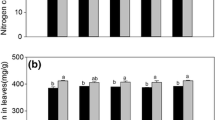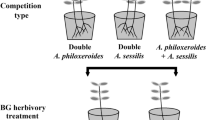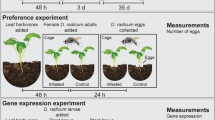Abstract
Interspecific interactions of herbivores sharing a host plant may be important in structuring herbivore communities. We investigated host plant-mediated interactions of root (Hylobius transversovittatus) and leaf herbivores (Galerucella calmariensis), released to control purple loosestrife (Lythrum salicaria) in North America, in field and potted plant experiments. In the potted plant experiments, leaf herbivory by G. calmariensis reduced H. transversovittatus larval survival (but not larval development) but did not affect oviposition preference. Root herbivory by H. transversovittatus did not affect either G. calmariensis fitness or oviposition preference. In field cage experiments, we found no evidence of interspecific competition between root and leaf herbivores over a 4-year period. Our data suggest that large populations of leaf beetles can negatively affect root-feeding larvae when high intensity of leaf damage results in partial or complete death of belowground tissue. Such events may be rare occurrences (or affected by experimental venue) since field data differed from data obtained from potted plant experiments, particularly at high leaf beetle densities. Interspecific interactions between G. calmariensis and H. transversovittatus are possible and may negatively affect either species, but this is unlikely to occur unless heavy feeding damage results in partial or complete plant death.





Similar content being viewed by others
References
Awmack CS, Leather SR (2002) Host plant quality and fecundity in herbivorous insects. Annu Rev Entomol 47:817–844
Bardgett RD, Wardle DA (2003) Herbivore mediated links between aboveground and belowground communities. Ecology 84:2258–2268
Bezemer TM, Wagenaar R, van Dam NM, Wäkers FL (2003) Interactions between above- and belowground insect herbivores as mediated by the plant defence system. Oikos 101:555–562
Bezemer TM, Wagenaar R, van Dam NM, van Der Putten WH, Wäkers FL (2004) Above- and below-ground terpenoid aldehyde induction in cotton, Gossypium herbaceum following root and leaf injury. J Chem Ecol 30:53–67
Blossey B (1993) Herbivory below ground and biological weed control: life history of a root boring-weevil on purple loosestrife. Oecologia 94:380–387
Blossey B (1995a) Coexistence of two leaf-beetles in the same fundamental niche. Distribution, adult phenology and oviposition. Oikos 74:225–234
Blossey B (1995b) Impact of Galerucella pusilla and G. calmariensis (Coleoptera: Chrysomelidae) on field populations of purple loosestrife (Lythrum salicaria). In: Delfosse ES, Scott RR (eds) Proceedings of the VIIIth International Symposium on the Biological Control of Weeds, 2–7 February 1992, Lincoln University, Canterbury. DSIR/CSIRO, Melbourne, pp 27–31
Blossey B (1995c). A comparison of various approaches for evaluating potential biological control agents using insects on Lythrum salicaria. Biol Contr 5:113–122
Blossey B, Hunt-Joshi TR (2003) Belowground herbivory by insects: influence on plants and aboveground herbivores. Annu Rev Entomol 48:521–547
Blossey B, Schat M (1997) Performance of Galerucella calmariensis (Coleoptera: Chrysomelidae) on different North American populations of purple loosestrife. Environ Entomol 26:439–445
Blossey B, Eberts D, Morrison E, Hunt TR (2000) Mass rearing the weevil Hylobius transversovittatus (Coleoptera: Curculionidae), biological control agent of Lythrum salicaria, on semiartificial diet. J Econ Entomol 93:1644–1656
Blossey B, Skinner LC, Taylor J (2001) Impact and management of purple loosestrife (Lythrum salicaria) in North America. Biodiversity Conserv 10:1787–1807
Bossart JL (2003) Covariance of preference and performance on normal and novel hosts in a locally monophagous and locally polyphagous butterfly population. Oecologia 135:477–486
Brown VK, Gange AC (1990) Insect herbivory below ground. Adv Ecol Res 20:1–58
Connell JH (1983) On the prevalence and relative importance of interspecific competition: evidence from field experiments. Am Nat 122:661–696
Craig TP, Abrahamson WG, Itami JK, Horner JD (1999) Oviposition preference and offspring performance of Eurosta solidaginis on genotypes of Solidago altissima. Oikos 89:119–128
Cronin JT, Abrahamson WG (2001) Goldenrod stem galler preference and performance: effects of multiple herbivores and plant genotype. Oecologia 127:87–96
Denno RF, McClure MS, Ott JR (1995) Interspecific interactions in phytophagous insects: competition reexamined and resurrected. Annu Rev Entomol 40:297–331
Faeth SH (1986a) Indirect interactions between temporally separated herbivores mediated by the host plant. Ecology 67:479–494
Faeth SH (1986b) Interspecific and intraspecific interactions via plant responses to folivory: an experimental field test. Ecology 73:1802–1813
Fondriest SM, Price PW (1997) Oviposition site resource quantity and larval establishment for Orellia occidentalis (Diptera: Tephritidae) on Cirsium wheeleri. Environ Entomol 25:321–326
Fox CW, Lalonde RG (1993) Host confusion and the evolution of insect diet breadths. Oikos 67:577–581
Grevstad FS, Herzig AL (1997) Quantifying the effects of distance and conspecifics on colonization: experiments and models using the loosestrife leaf beetle, Galerucella calmariensis. Oecologia 110:60–68
Hairston NGJ, Smith FE, Slobodkin LB (1960) Community structure, population control and competition. Am Nat 94:421–425
Hight SD, Blossey B, Laing J, DeClerck-Floate R (1995) Establishment of insect biological control agents from Europe against Lythrum salicaria in North America. Environ Entomol 24:967–977
Hunt-Joshi TR, Blossey B, Root RB (2004) Individual and combined effects of root and leaf herbivory on purple loosestrife (Lythrum salicaria): implications for plant performance and wetland plant communities. Ecol Appl 14:1574–1589
Ikonen A, Sipura M, Miettinen S, Tahvanainen J (2003) Evidence for host race formation in the leaf beetle Galerucella lineola. Entomol Exp Appl 108:179–183
Inbar M, Doostdar H, Mayer R (1999) Effects of sessile whitefly nymphs (Homoptera: Aleyrodidae) on leaf-chewing larvae (Lepidoptera: Noctuidae). Environ Entomol 28:353–357
Karban R (1989) Community organization of Erigeron glaucus folivores: effects of competition, predation, and host plant. Ecology 70:1028–1039
Karban R, Adler FR (1996) Induced resistance to herbivores and the information content of early season attack. Oecologia 107:379–385
Katovich EJ, Becker RL (2001) Establishment of Hylobius transversovittatus on Galerucella spp. stressed and non-stressed loosestrife plants. LCMR semi-annual report. Minnesota Department of Natural Resources, Minneapolis, Minn.
Katovitch EJS, Becker RL, Ragsdale DW (1999) Effect of Galerucella spp. on survival of purple loosestrife (Lythrum salicaria) roots and crowns. Weed Sci 47:360–365
Little RC, Milliken GA, Stroup WW (1996) SAS systems for mixed models. SAS Institute, Cary, N.C.
Malecki RA, Blossey B, Hight SD, Schroeder D, Kok LT, Coulson JR (1993) Biological control of purple loosestrife. Bioscience 43:680–686
Maron JL (1998) Insect herbivory above-and belowground: individual and joint effects on plant fitness. Ecology 79:1281–1293
Maron JL (2001) Intraspecific competition and subterranean herbivory: individual and interactive effects on bush lupine. Oikos 92:178–186
Masters GJ, Brown VK, Gange AC (1993) Plant mediated interactions between above- and below-ground insect herbivores. Oikos 66:148–151
Masters GJ, Jones TH, Rogers M (2001) Host-plant mediated effects of root herbivory on insect seed predators and their parasitoids. Oecologia 127:246–250
McEvoy P, Cox C, Coombs E (1991) Successful biological control of ragwort, Senecio jacobaea, by introduced insects in Oregon. Ecol Appl 1:430–442
Moran NA, Whitham TG (1990) Interspecific competition between root-feeding and leaf-galling aphids mediated by host-plant resistance. Ecology 71:1050–1058
Nötzold R, Blossey B, Newton E (1998) The influence of below ground herbivory and plant competition on growth and biomass allocation of purple loosestrife. Oecologia 113:82–93
Petersen M, Sandstrom J (2001) Outcome of indirect competition between two aphid species mediated by responses in their common host plant. Funct Ecol 15:525–534
Poveda K., Steffan-Dewenter I, Schey S, Tscharntke T. (2003) Effects of below- and above-ground herbivores on plant growth, flower visitation and seed set. Oecologia 135:601–603
Price PW (1991) The plant vigor hypothesis and herbivore attack. Oikos 62:244–251
van der Putten WH, Vet LEM, Harvey JA, Wäckers FL (2001) Linking above- and below ground multitrophic interactions of plants, herbivores, pathogens and antagonists. Trends Ecol Evol 16:547–554
SAS Institute (2000) Software release 8.01. SAS Institute, Cary, N.C.
Scheirs J, De Bruyn L, Verhagen R (2001) Nutritional benefits of the leaf-mining behaviour of two grass miners: a test of the selective feeding hypothesis. Ecol Entomol 26:509–516
Shiojiri, K, Takabayashi J, Yano S, Takafuji A (2002) Oviposition preferences of herbivores are affected by tritrophic interaction webs. Ecol Lett 5:186–192
Singer MC, Thomas CD, Billington HL, Parmesan C (1994) Correlates of speed of evolution of host preference in a set of twelve populations of the butterfly Euphydryas editha. Ecoscience 1:107–114
Thompson JN (1988) Evolutionary ecology and the relationship between oviposition preference and performance of offspring in phytophagous insects. Entomol Exp Appl 47:3–14
Wardle DA, Bardgett RD, Klironomos JN, Setälä H, van der Putten WH, Wall DH (2004) Ecological linkages between aboveground and belowground biota. Science 304:1629–1633
Acknowledgements
We especially thank G. Bartus for his help and support throughout this project as well as E. Morrison, J. Meyburg, and T. Sukontarak. D. Connoly, D. Odell (New York Department of Environmental Conservation) and S. Sleggs (Ducks Unlimited) who allowed use of Marten’s Tract. Inmates of the New York Correctional Services provided invaluable help in maintaining field plots. Earlier versions of the manuscript was greatly improved by suggestions from R. B. Root and V. A. Nuzzo. We also appreciate the thoughtful comments of two anonymous reviewers. Funding was partially provided by a National Science Foundation Dissertation Improvement Grant (no. 0072974), hatch project 410 to R. B. Root and through the Biological Control of Non-Indigenous Plants Species Program at Cornell University.
Author information
Authors and Affiliations
Corresponding author
Rights and permissions
About this article
Cite this article
Hunt-Joshi, T.R., Blossey, B. Interactions of root and leaf herbivores on purple loosestrife (Lythrum salicaria). Oecologia 142, 554–563 (2005). https://doi.org/10.1007/s00442-004-1747-4
Received:
Accepted:
Published:
Issue Date:
DOI: https://doi.org/10.1007/s00442-004-1747-4




